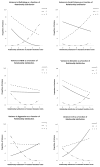Romantic Relationship Satisfaction Moderates the Etiology of Adult Personality
- PMID: 26581694
- PMCID: PMC4720567
- DOI: 10.1007/s10519-015-9767-x
Romantic Relationship Satisfaction Moderates the Etiology of Adult Personality
Abstract
The heritability of major normative domains of personality is well-established, with approximately half the proportion of variance attributed to genetic differences. In the current study, we examine the possibility of gene × environment interaction (G×E) for adult personality using the environmental context of intimate romantic relationship functioning. Personality and relationship satisfaction are significantly correlated phenotypically, but to date no research has examined how the genetic and environmental components of variance for personality differ as a function of romantic relationship satisfaction. Given the importance of personality for myriad outcomes from work productivity to psychopathology, it is vital to identify variables present in adulthood that may affect the etiology of personality. In the current study, quantitative models of G×E were used to determine whether the genetic and environmental influences on personality differ as a function of relationship satisfaction. We drew from a sample of now-adult twins followed longitudinally from adolescence through age 29. All participants completed the Multidimensional Personality Questionnaire (MPQ) and an abbreviated version of the Dyadic Adjustment Scale. Biometric moderation was found for eight of the eleven MPQ scales examined: well-being, social potency, negative emotionality, alienation, aggression, constraint, traditionalism, and absorption. The pattern of findings differed, suggesting that the ways in which relationship quality moderates the etiology of personality may depend on the personality trait.
Keywords: Biometric moderation; G×E; Personality; Relationship satisfaction.
Figures



References
-
- Akaike H. Factor analysis and AIC. Psychometrika. 1987;52:317–332.
-
- Belsky J, Pluess M. Beyond diathesis stress: Differential susceptibility to environmental influences. Psychological Bulletin. 2009;135:885–908. - PubMed
-
- Bleidorn W, Kandler C, Caspi A. The behavioural genetics of personality development in adulthood--classic, contemporary, and future trends. European Journal of Personality. 2014;28:244–255.
-
- Boomsma D, de Geus E, van Baal G, Koopmans J. A religious upbringing reduces the influence of genetic factors on disinhibition: Evidence for interaction between genotype and environment on personality. Twin Research. 1999;2:115–125. - PubMed
-
- Bouchard TJ, Jr, Loehlin JC. Genes, evolution, and personality. Behavior Genetics. 2001;31:243–273. - PubMed
Publication types
MeSH terms
Grants and funding
LinkOut - more resources
Full Text Sources
Other Literature Sources

